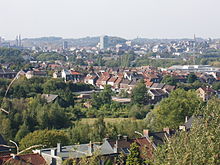The Pays Noir (French for 'black country') refers to a region of Belgium, centered on the city of Charleroi in the province of Hainaut in Wallonia so named for the geological presence of coal. In the 19th century the region rapidly industrialised first with coal mines, then with related industries such as steel manufacture and glass production.

Description
editThe region, centred on Charleroi,[1] also known as the Pays de Charleroi includes the communes of Aiseau-Presles, Charleroi, Châtelet, Courcelles, Farciennes, Fleurus, Fontaine-l'Évêque, Gerpinnes, Les Bons Villers and Pont-à-Celles.[2]
In the west, the Pays Noir borders the Centre-region around the town of La Louvière. Geologically, the region - as well as the other coal bearing areas in Belgium - lies on the northern edge of the Rhenish Massif.[3]
See also
edit- Sillon industriel, the industrial valley of Belgium, the western part of which lies in the Pays Noir
- Borinage
- Black Country, a similar early industrial region in the English Midlands
References
edit- ^ Leanne Logan; Geert Cole (2004). Belgium & Luxembourg. Lonely Planet. Charleroi, pp.231-232. ISBN 978-1-74059-340-3.
- ^ "Maison du tourisme du Pays de Charleroi". Archived from the original on 2011-09-29. Retrieved 2011-08-30.
- ^ Caractéristiques des bassins industriels dans l'Eurégio Meuse-Rhin, section 2.
Further reading
edit- Suzanne Pasleau (2003). "Caractéristiques des bassins industriels dans l'Eurégio Meuse-Rhin". Fédéralisme Régionalisme (in French). 3. Archived from the original on 2012-03-01. Retrieved 2010-09-07.
